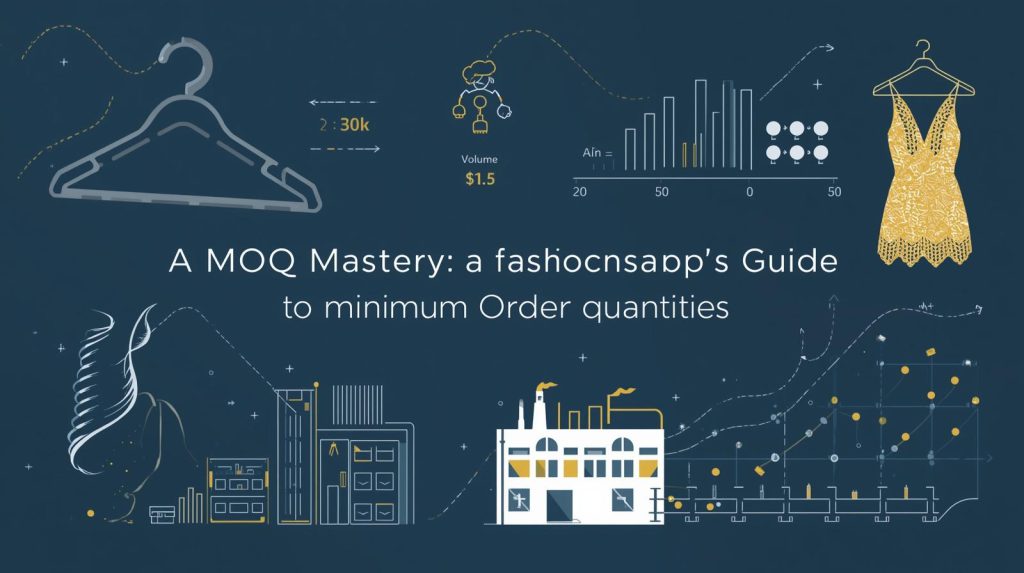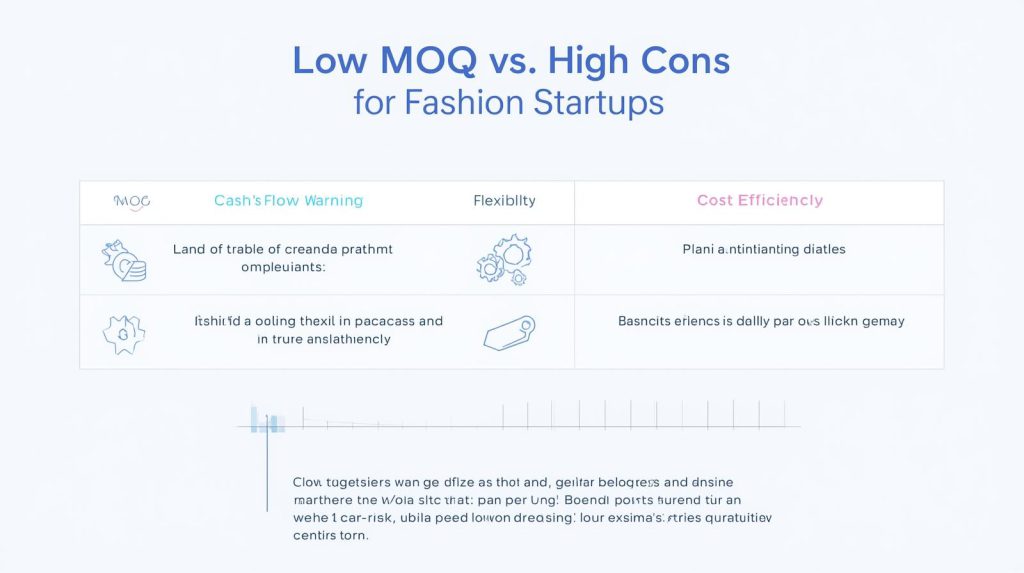
Why MOQ Matters: A Guide for Fashion Startups
Understanding MOQ and Its Impact on Your Fashion Business
For fashion startups navigating the complex world of manufacturing, Minimum Order Quantity (MOQ) is one of the most critical concepts to understand. MOQ refers to the smallest number of units a supplier is willing to produce for a single order49. This requirement directly impacts your production costs, inventory management, and cash flow – all essential elements for a growing fashion brand.
While MOQ requirements might seem like obstacles, they actually represent an opportunity to optimize your supply chain and build stronger manufacturer relationships. This comprehensive guide will help you understand why MOQs exist, how to negotiate them effectively, and strategies to turn these requirements into advantages for your fashion startup.
What Exactly is MOQ?
MOQ (Minimum Order Quantity) is the minimum number of units a manufacturer requires you to purchase in a single order49. These requirements vary significantly between suppliers based on several factors:
- Material type (specialty fabrics often have higher MOQs)
- Production complexity (detailed work requires larger orders)
- Supplier size (larger factories typically have higher MOQs)
- Seasonal factors (capacity affects flexibility)
For example, a basic cotton t-shirt might have an MOQ of 50-100 units, while detailed embroidery work might require 500+ units to be economically viable for the manufacturer.
Why Suppliers Implement MOQ Requirements
Understanding the manufacturer’s perspective is crucial to successful negotiations. Suppliers don’t implement MOQs arbitrarily; these requirements exist for several logical business reasons:
The Economics of Clothing Production
Manufacturing apparel involves significant fixed costs that don’t change regardless of order size. These include:

- Pattern making and sample development
- Machine setup and calibration
- Material sourcing and preparation
- Quality control systems
When spread across more units, these fixed costs become more manageable for both parties. This is why suppliers often have higher MOQs for custom designs compared to stock items10.
Production Efficiency and Profitability
Most clothing manufacturers operate on thin profit margins (typically 3-4%), requiring larger orders to maintain profitability9. Smaller orders often require the same administrative attention and production line setup as larger ones, making them less efficient from the manufacturer’s perspective.
Table: Why Suppliers Need MOQs
| Supplier Need | Impact on Startup | Potential Solution |
|---|---|---|
| Cost recovery on setup | Higher per-unit cost on small runs | Consolidate orders or choose simpler designs |
| Production efficiency | Less flexibility on modifications | Plan collections carefully in advance |
| Profit margin maintenance | Higher initial investment required | Negotiate slightly higher prices for lower MOQs |
| Material purchasing | Limited fabric/trim options | Use stock materials instead of custom |
How MOQ Impacts Your Fashion Startup
Cash Flow Considerations
For emerging fashion brands, cash flow management is paramount. High MOQs can quickly tie up significant capital in inventory that may take months to sell. This affects your ability to:
- Invest in marketing and customer acquisition
- Develop new designs and collections
- Maintain operational expenses
- Weather unexpected challenges
Risk Management
Inventory risk increases with higher MOQs. If a product doesn’t sell as expected, you’re left with dead stock that ties up capital and storage space. This is particularly challenging for fashion startups testing market reception to new designs.
Pro Tip: Start with our low MOQ woven labels to minimize risk while establishing your brand identity. These premium labels are available with MOQs as low as 100 units, perfect for startups.
Quality vs. Quantity Balance
Paradoxically, very low MOQs can sometimes indicate quality compromises. Manufacturers willing to produce extremely small batches (under 50 units) may cut corners on quality control or use inferior materials. The key is finding suppliers with MOQs that match your growth stage.
Strategies to Manage MOQ Requirements
Negotiation Techniques
Successful MOQ negotiation begins with understanding the supplier’s constraints and finding mutually beneficial solutions:
- Build relationships rather than treating negotiations as transactions
- Offer higher prices per unit in exchange for lower quantities
- Commit to future orders to demonstrate your growth potential
- Combine SKUs to meet overall quantity requirements while maintaining product variety
Alternative Approaches
When direct negotiation doesn’t yield the desired MOQ, consider these strategies:
- Start with stock designs that have lower MOQs, then introduce custom elements as you grow
- Use local production for small batches despite higher per-unit costs
- Join forces with other startups to combine orders (though this requires careful coordination)
- Begin with accessories or simple items that typically have lower MOQs before moving to complex garments
Explore options: Our custom care labels offer flexible MOQs depending on material and printing complexity, allowing you to choose the option that best fits your current needs and budget.
Case Studies: Fashion Startups That Mastered MOQ
The Sustainable Athleisure Brand
A London-based sustainable activewear startup faced MOQs of 300+ units for their custom recycled fabric leggings. Instead of compromising, they:
- Started with smaller batches of simpler designs using stock fabrics
- Used the initial collections to build brand awareness and customer loyalty
- Negotiated staggered production (delivering in batches rather than all at once)
- Within 18 months, grew enough to meet the original MOQ requirements comfortably
The Ethical Jewelry and Apparel Label
A Nordic jewelry brand expanding into linen clothing faced challenges with high fabric MOQs. Their solution:
- Partnered with other small brands to collectively meet fabric MOQs
- Designed multi-functional garments to reduce the number of separate SKUs needed
- Focused on timeless designs that wouldn’t become obsolete quickly
- Used pre-orders to gauge demand before committing to full production
MOQ and Production Planning Timeline
Table: Typical MOQ Timeline for Fashion Startups
| Stage | Recommended MOQ Strategy | Key Considerations |
|---|---|---|
| Concept/Pre-launch | Lowest possible MOQs; focus on samples and small batches | Prioritize speed and flexibility over cost; test market response |
| Early Growth (1-2 years) | Balanced approach; moderate MOQs for core products | Identify bestsellers; build supplier relationships; optimize inventory turnover |
| Established Brand (3+ years) | Higher MOQs for cost efficiency; maintain lower options for new lines | Leverage volume discounts; implement sophisticated demand forecasting |
How Technology is Changing MOQ Dynamics
The rise of on-demand manufacturing and digital printing technologies is gradually transforming MOQ requirements. While traditional manufacturing will always have scale advantages, new options are emerging:
- Digital printing allows for smaller fabric batches without quality loss
- 3D knitting technology reduces setup requirements for certain garments
- AI-driven production planning helps factories optimize smaller batches more efficiently
These technologies are particularly beneficial for fashion startups looking to minimize risk while maintaining quality and design integrity.
Action Plan: Managing MOQ as a Growing Brand
Immediate Steps (0-3 months)
- Audit your current collection to identify which items justify higher MOQs
- Research suppliers with MOQ policies matching your scale
- Initiate conversations with potential manufacturing partners about their flexibility
- Start small with our basic woven labels to establish relationships
Medium-term Strategy (3-12 months)
- Analyze sales data to identify your best-performing products
- Gradually increase MOQs for core items with consistent demand
- Develop stronger supplier relationships through timely payments and clear communication
- Implement inventory management systems to optimize stock levels
Long-term Approach (12+ months)
- Consider vertical integration for key products with stable demand
- Develop exclusive supplier partnerships with preferential MOQ terms
- Implement demand forecasting to optimize production planning
- Explore alternative production models like on-demand for slow-moving items
Conclusion: MOQ as a Strategic Tool
Rather than viewing Minimum Order Quantity as a barrier, successful fashion startups treat it as a strategic consideration in their growth plan. By understanding supplier perspectives, negotiating creatively, and implementing smart inventory management, you can turn MOQ challenges into competitive advantages.
The goal isn’t necessarily to find the lowest possible MOQ, but to find the right MOQ for your current business stage and growth trajectory. As you evolve from startup to established brand, your MOQ strategy should evolve with you, always balancing risk, cost, and opportunity.